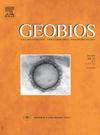意大利托斯卡纳早更新世犀牛科的新发现和意大利早更新世犀牛的记录
IF 1.6
4区 地球科学
Q2 PALEONTOLOGY
引用次数: 0
摘要
一个几乎完整的下颌骨从下上新世沉积的阿尔西尔(托斯卡纳)首次描述和调查。该标本属于大上新世上新世中期至中新世晚期在意大利发现的大上新世上新世上新世。所研究的标本比Stephanorhinus etruscus和S. jeanvireti大,形态上与来自法国蒙伯利埃(Montpellier)、西班牙维拉盆地(Vera Basin)和意大利Val di Pugna Fangonero的P. megarhinus吻合。该标本代表了该物种在意大利上新世的第一个地层记录,之前的发现可追溯到19世纪或20世纪初,因此缺乏地层控制。根据获得的结果,可以评估P. megarhinus在上新世早期在意大利的出现,并确认该物种的长期存在,其化石记录涵盖6.7 Ma至3.5 Ma的时间跨度。在这段时间里,巨尾鼩似乎确实经历了体重减少的趋势。本文章由计算机程序翻译,如有差异,请以英文原文为准。
New early Pliocene Rhinocerotidae findings from Tuscany (Italy) and the Pliocene rhinocerotine record in Italy
An almost complete mandible from the Lower Pliocene deposits of Arcille (Tuscany) is described and investigated for the first time. The specimen is assigned to Pliorhinus megarhinus, which is documented in Italy from the latest Miocene to the mid-Pliocene. The studied specimen is larger than Stephanorhinus etruscus and S. jeanvireti, and morphologically fits P. megarhinus from the Early Pliocene of Montpellier (France), Vera Basin (Spain) and Val di Pugna Fangonero (Italy). This specimen represents the first stratigraphically well-documented Pliocene record of this species in Italy, the previous discoveries dating back to the 19th century or the beginning of the 20th century, hence lacking stratigraphic control. According to the obtained results, it is possible to assess the occurrence of P. megarhinus during the earliest Pliocene in Italy as well as to confirm the long-lasting persistence of this species, whose fossil record covers a timespan between 6.7 Ma and 3.5 Ma. During that time, P. megarhinus did seemingly undergo a trend of body mass reduction.
求助全文
通过发布文献求助,成功后即可免费获取论文全文。
去求助
来源期刊

Geobios
地学-古生物学
CiteScore
3.30
自引率
6.20%
发文量
28
审稿时长
6-12 weeks
期刊介绍:
Geobios publishes bimonthly in English original peer-reviewed articles of international interest in any area of paleontology, paleobiology, paleoecology, paleobiogeography, (bio)stratigraphy and biogeochemistry. All taxonomic groups are treated, including microfossils, invertebrates, plants, vertebrates and ichnofossils.
Geobios welcomes descriptive papers based on original material (e.g. large Systematic Paleontology works), as well as more analytically and/or methodologically oriented papers, provided they offer strong and significant biochronological/biostratigraphical, paleobiogeographical, paleobiological and/or phylogenetic new insights and perspectices. A high priority level is given to synchronic and/or diachronic studies based on multi- or inter-disciplinary approaches mixing various fields of Earth and Life Sciences. Works based on extant data are also considered, provided they offer significant insights into geological-time studies.
 求助内容:
求助内容: 应助结果提醒方式:
应助结果提醒方式:


